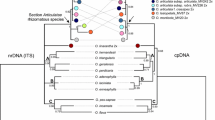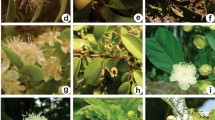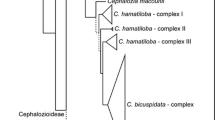Abstract
As part of our ongoing phylogenetic study of genusHypericum, nuclear ribosomal DNA internal transcribed spacer sequences were analyzed for 36 species ofHypericum as ingroup and two species ofThornea as outgroup. This sampling included most of the previously described species from both Korea and Japan. The ITS phylogeny suggested that the surveyedHypericum species belong to a monophyletic section,Trigynobrathys, and a polyphyletic section,Hypericum. In addition, two monotypic sections,Sampsonia andRoscyna, were identified. Members of sectionHypericum occur in four different lineages worldwide, which imply at least four independent origins. The Korean and Japanese species of sectionHypericum form a monophyletic group, except forH. vulcanicum. Instead, that particular species belongs to a distinct monophyletic group withH. scoreri andH. formosa from other geographic areas, and is a sister to sectionTrigynobrathys. The Korean and Japanese species of sectionTrigynobrathys show a monophyletic origin.H. sampsonii is now recognized as a distinct section rather than being a member of sectionsHypericum orDrosocarpium, as had been indicated previously. Our results differ somewhat from those of recent morphological and cytological studies. The phylogenetic relationships among Korean and Japanese species have now been mostly resolved via ITS phylogeny.
Similar content being viewed by others

Literature Cited
Doyle JJ, Doyle JL (1987) A rapid isolation procedure for small quantities of fresh leaf material. Phytochem Bull 19:11–15
Farris JS (1989) The retention index and homoplasty excess. Syst Zool 38:406–407
Farris JS, Albert VA, Kallersjo M, Lipscomb D, Kluge AG (1996) Parsimony jackknifing outperforms neighbor-joining. Cladistics 12:99–124
Felsenstein J (1985) Confidence limits on phylogenies: An approach using the bootstrap. Evolution 39:783–791
Hance HF (1865) Descriptions of four new plants from southern China. J Bot 3:378–381
Hillis DM, Huelsenbeck JP (1992) Signal, noise and reliability in molecular phylogenetic analyses. J Heredity 83:189–195
Jaubert C, Spach E (1842) Illustrationes Plantarum Orientalium I. Apud Roret Bibliopolam Paris
Kato T (1990) Taxonomical studies on theHypericum pseudopetiolatum complex. J Fac Sci Univ Tokyo (III) 14:341–413
Keller R (1925)Hypericum.In A Engler, K Prantl, eds, Die Naturlichen Pflanzenfamilien, Ed 2. Leipzig, Berlin, pp 175–183
Kim K-J, Jansen RK (1994) Comparisons of phylogenetic hypotheses among different data sets in dwarf dandelions (Krigia): Additional information from internal transcribed spacer sequences of nuclear ribosomal DNA. Plant Syst Evol 190:157–185
Kimura M (1980) A simple method for estimating evolutionary rates of base substitutions through comparative studies of nucleotide sequences. J Mol Evol 16:111–120
Kimura Y (1951) Hypericaceae.In T Nakai, M Honda, eds, Nova Flora Japonica, Vol 10. Natural Science Museum, Tokyo
Kluge AG, Farris JS (1969) Quantitative phyletics and the evolution of anurans. Syst Zool 18:1–32
Kogi M (1984) A karyomorphological study of the genusHypericum (Hypericaceae) in Japan. Bot Mag Tokyo 97:333–343
Kumar S, Tamura K, Jakobsen IB, Nei M (2001) MEGA2: Molecular evolutionary genetics analysis software. Bioinformatics 17:1244–1245
Lee TB (1979) Illustrated Flora of Korea. Hwangmunsa, Seoul
Lee WT (1996a) Linneamenta Florae Koreae. Academy Publishing Company, Seoul
Lee YN (1996b) Flora of Korea. Kyohaksa, Seoul Linneaus CV (1753) Species Plantarum. Tomus I. Holmiae, Stockholm
Loockerman DJ, Jansen RK (1996) The use of herbarium material for DNA studies.In TF Stuessy, SH Sohmer, eds, Sampling the Green World. Columbia University Press, New York, pp 205–220
Ohwi J (1975) Flora of Japan. Shibundo, Tokyo
Ohwi J (1984) Flora of Japan. Smithsonian Institution Press, Washington DC
Park MK (1974) Key to the Herbaceous Plants in Korea. Chungumsa, Seoul
Park S-J, Kim K-J (2005) Two new species ofHypericum from Korea (Hypericaceae),H. chejuense andH. jeon-jocksanense. Novon 15 (In press)
Posada D, Crandall KA (1998) Modeltest: Testing the model of DNA substitution. Bioinformatics 14:817–818.
Robson NKB (1977) Studies in the genusHypericum L. (Guttiferae) I. Infrageneric classification. Bull Br Mus Nat Hist (Bot) 5: 291–355
Robson NKB (1990) Studies in the genus Hypericum L. (Guttiferae) 8. Sections 29. Brathys (Part 2) and 30. Trig-ynobrathys.Bull Br Mus Nat Hist (Bot) 20: 1–151
Robson NKB (2001) Studies in the genus Hypericum L. (Guttiferae) 4(1). Sections 7. Roscyna to 9. Hypericum sensu lata (Part 1). Bull Br Mus Nat Hist (Bot) 31: 37–88
Sambrook J, Fritsch EF, Maniatis R (1989) Molecular Cloning, A Laboratory Manual, Ed 2. Cold Spring Harbor Laboratory Press, New York
Satake Y, Ohwi J, Kitamura S, Wataris S, Tominar T (1981) Wild Flowers of Japan. Heibonsha, Tokyo
Spach E (1836) Hypericacearum monographiae fragments. Annals Sci Nat Ser 2, Bot 5: 157–176
Swofford DL (2002) PAUP: Phylogenetic analysis using parsimony and other methods (ver. 4.0), Sinauer Associates, Sunderland, MA Thompson JD, Gibson TJ, Plewniak F, Jeanmougin F, Hig-gins DC (1997) The ClustalX windows interface: Flexible strategies for multiple sequence alignment aided by quality analysis tools. Nucleic Acids Res 24:4876–4882
White TT, Bruns T, Lee S, Tayler J (1990) Amplification and direct sequencing of fungal ribosomal RNA genes for phylogenetics. In M Innis, D Gelfand, J Sninsky, T White, eds, PCR Protocols: A Guide to Methods and Applications. Academic Press, California, pp 315–322
Author information
Authors and Affiliations
Corresponding author
Rights and permissions
About this article
Cite this article
Park, SJ., Kim, KJ. Molecular phylogeny of the genusHypericum (Hypericaceae) from Korea and Japan: evidence from nuclear rDNA ITS sequence data. J. Plant Biol. 47, 366–374 (2004). https://doi.org/10.1007/BF03030553
Received:
Accepted:
Issue Date:
DOI: https://doi.org/10.1007/BF03030553



